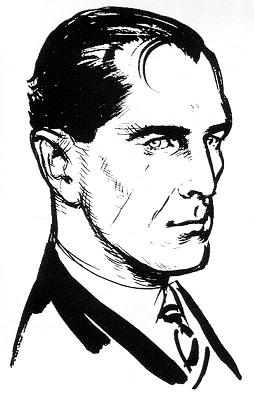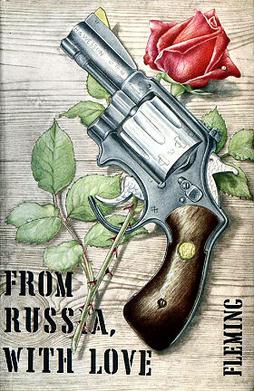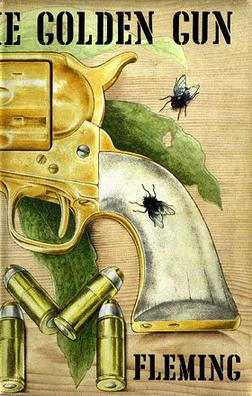
The James Bond series focuses on the titular character, a fictional British Secret Service agent created in 1953 by writer Ian Fleming, who featured him in twelve novels and two short-story collections. Since Fleming's death in 1964, eight other authors have written authorised Bond novels or novelisations: Kingsley Amis, Christopher Wood, John Gardner, Raymond Benson, Sebastian Faulks, Jeffery Deaver, William Boyd, and Anthony Horowitz. The latest novel is With a Mind to Kill by Anthony Horowitz, published in May 2022. Additionally Charlie Higson wrote a series on a young James Bond, and Kate Westbrook wrote three novels based on the diaries of a recurring series character, Moneypenny.

Ian Lancaster Fleming was a British writer, best known for his postwar James Bond series of spy novels. Fleming came from a wealthy family connected to the merchant bank Robert Fleming & Co., and his father was the Member of Parliament (MP) for Henley from 1910 until his death on the Western Front in 1917. Educated at Eton, Sandhurst, and, briefly, the universities of Munich and Geneva, Fleming moved through several jobs before he started writing.

From Russia, with Love is the fifth novel by the English author Ian Fleming to feature his fictional British Secret Service agent James Bond. Fleming wrote the story in early 1956 at his Goldeneye estate in Jamaica; at the time he thought it might be his final Bond book. The novel was first published in the United Kingdom by Jonathan Cape on 8 April 1957.

Moonraker is the third novel by the British author Ian Fleming to feature his fictional British Secret Service agent James Bond. It was published by Jonathan Cape on 5 April 1955 and featured a cover design conceived by Fleming. The plot is derived from a Fleming screenplay that was too short for a full novel, so he added the passage of the bridge game between Bond and the industrialist Hugo Drax. In the latter half of the novel, Bond is seconded to Drax's staff as the businessman builds the Moonraker, a prototype missile designed to defend England. Unknown to Bond, Drax is German, an ex-Nazi now working for the Soviets; his plan is to build the rocket, arm it with a nuclear warhead, and fire it at London. Uniquely for a Bond novel, Moonraker is set entirely in Britain, which raised comments from some readers, complaining about the lack of exotic locations.

You Only Live Twice is the eleventh novel and twelfth book in Ian Fleming's James Bond series of stories. It was first published by Jonathan Cape in the United Kingdom on 26 March 1964 and sold out quickly. It was the last Fleming novel published in his lifetime. It is the concluding chapter in what is known as the "Blofeld Trilogy" after Thunderball and On Her Majesty's Secret Service.

The Man with the Golden Gun is the twelfth and final novel in Ian Fleming's James Bond series and fourteenth Bond book overall. It was first published by Jonathan Cape in the UK on 1 April 1965, eight months after the author's death. The novel was not as detailed or polished as the others in the series, leading to poor but polite reviews. Despite that, the book was a best-seller.

On Her Majesty's Secret Service is the tenth novel and eleventh book in Ian Fleming's James Bond series, first published in the UK by Jonathan Cape on 1 April 1963. After the relative disappointment of The Spy Who Loved Me, the author made a concerted effort to produce another novel adhering to the tried and tested formula. The initial and secondary print runs sold out, with over 60,000 books sold in the first month, double that of the previous book. Fleming wrote the book in Jamaica whilst the first film in the Eon Productions series of films, Dr. No, was being filmed nearby.

James Bond was an American ornithologist and expert on the birds of the Caribbean, having written the definitive book on the subject: Birds of the West Indies, first published in 1936. He served as a curator of the Academy of Natural Sciences of Philadelphia. His name was appropriated by writer Ian Fleming for his fictional British spy of the same name; the real Bond enjoyed knowing his name was being used this way, and references to him permeate the resulting media franchise.

The Spy Who Loved Me is the ninth novel and tenth book in Ian Fleming's James Bond series, first published by Jonathan Cape on 16 April 1962. It is the shortest and most sexually explicit of Fleming's novels, as well as a clear departure from previous Bond novels in that the story is told in the first person by a young Canadian woman, Vivienne Michel. Bond himself does not appear until two-thirds of the way through the book. Fleming wrote a prologue to the novel giving Michel credit as a co-author.

Octopussy and The Living Daylights is the 14th and final James Bond book written by Ian Fleming in the Bond series. The book is a collection of short stories published posthumously in the United Kingdom by Jonathan Cape on 23 June 1966.
Per Fine Ounce is the title of an unpublished novel by Geoffrey Jenkins featuring Ian Fleming's James Bond. It was completed c.1966 and is considered a "lost" novel by fans of James Bond because it was actually commissioned by Glidrose Productions, the official publishers of James Bond. It was rejected for publication, however, missing the opportunity to become the first continuation James Bond novel. The Adventures of James Bond Junior 003½, a novel written by the pseudonymous R. D. Mascott, was later published in 1967 featuring James Bond's nephew; Colonel Sun written by Kingsley Amis under the pseudonym Robert Markham was published in 1968 as the first adult continuation novel following Ian Fleming's The Man with the Golden Gun (1965).
In the 1950s and 1960s, Ian Fleming, creator of the fictional secret agent, James Bond, wrote a number of short stories featuring his creation that appeared in the collections For Your Eyes Only and Octopussy and The Living Daylights. Since 1997, several more short stories featuring Bond or set within the official James Bond universe have been published by authors who continued chronicling the world of Fleming's creation. The majority of these stories have, as of 2008, never been collected in book form, unlike the Fleming works. There are five exceptions: "Blast from the Past", "Midsummer Night's Doom" and "Live at Five" by Raymond Benson, "Your Deal, Mr. Bond" by Phillip and Robert King, and "Bond Strikes Camp" by Cyril Connolly which are discussed below.
A number of real-life inspirations have been suggested for James Bond, the fictional character created in 1953 by British author, journalist and Naval Intelligence officer Ian Fleming (1908–1964); Bond appeared in twelve novels and nine short stories by Fleming, as well as a number of continuation novels and twenty-six films, with seven actors playing the role of Bond.
James Bond is a media franchise based on the fictional British Secret Service agent created in 1953 by writer Ian Fleming.

Young Bond is a series of young adult spy novels featuring Ian Fleming's secret agent James Bond as a young teenage boy attending school at Eton College in the 1930s. The series, written by Charlie Higson, was originally planned to include only five novels; however, after the release of the fifth novel, Higson considered the possibility of a second series. In October 2013 it was confirmed that a second series of four novels was in development, with the first novel due for release in Q3 2014, but it would be penned by Steve Cole while Higson continued work on his young adult zombie series, The Enemy.

Casino Royale is the first novel by the British author Ian Fleming. Published in 1953, it is the first James Bond book, and it paved the way for a further eleven novels and two short story collections by Fleming, followed by numerous continuation Bond novels by other authors.

Gwynedd Mercy University (GMercyU) is a private Roman Catholic university in Lower Gwynedd Township, Pennsylvania. It occupies a 160-acre (65-hectare) campus in the Archdiocese of Philadelphia.

Goldeneye is the original name of novelist Ian Fleming's estate on Oracabessa Bay on the northern coastline of Jamaica. He bought 15 acres (6.1 ha) adjacent to the Golden Clouds estate in 1946 and built his home on the edge of a cliff overlooking a private beach. The three-bedroom structure was constructed from Fleming's sketch, fitted with wooden jalousie windows and a swimming pool. Fleming's visitors at Goldeneye included actors, musicians, and filmmakers. As of 2010 the property operates as Goldeneye Hotel and Resort, consisting of Fleming's main house and several cottages.

Commander James Bond is a character created by the British journalist and novelist Ian Fleming in 1953. He is the protagonist of the James Bond series of novels, films, comics and video games. Fleming wrote twelve Bond novels and two short story collections. His final two books—The Man with the Golden Gun (1965) and Octopussy and The Living Daylights (1966)—were published posthumously.













